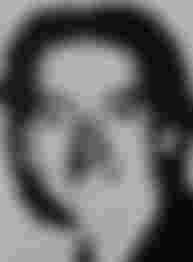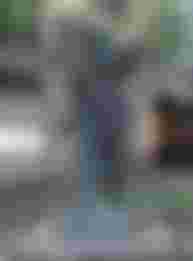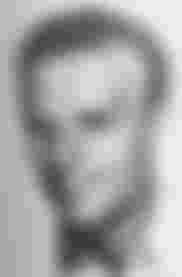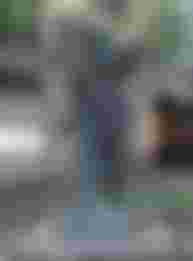Rade Končar was born on August 6, 1911 in the village of Končarev Kraj, near Lika's Plitvice Lakes. At the time of his birth, this village, located halfway between Otočac and Korenica, consisted of about twenty families with over 100 inhabitants. As most of the family's last name was Končar, the village was called Končar's region. Končari are Serbs and they moved to this area in the 16th century, most probably from the confluence of the Piva and Tara rivers. Rad's oldest ancestor, who settled in Končar's Kraj, was his great-grandfather Vasilije Končar, who built a wooden hut for cattle here. His son, Radin's great-grandfather, Vasilije, built a log house, and just before Rad, his father Geodon Geca, built a stone house, which was set on fire during the Second World War.
Vasilije Končar lived for many years and died during the First World War. Since his son Mile and daughter-in-law Milija died early, Vasilije raised his grandson Geodon, who was born on September 14, 1882. In 1904 he married Staka Končar called Žuna, the daughter of Latinka and Vaja Končar, born on October 6, 1883. Geco and Staka gave birth to twelve children.
Milka married Drakulić, was born on January 2, 1905, was a participant in NOR since 1941, and died in 1943 from a typhus epidemic.
Milan Mile Končar was born on May 18, 1906, was a miner, and died in 1937 in Valjevo from tuberculosis.
Rade Končar.

Dragica married Drakulić and was born on January 4, 1913. She was a participant in the National Liberation War and the bearer of the Partisan Memorial in 1941, and after the Second World War she lived in Rijeka Drakulić.

Nikola Končar was born in 1915, was a participant in the People's Liberation War and the bearer of the Partisan Memorial in 1941, and died in a hunt in 1954.
Soka Končar was born on May 14, 1919, and died 15 days later
Bogdan Končar was born on May 8, 1920, he had been a participant in the NOR since 1941, and he was shot in January 1943 as the secretary of the KPH District Committee for Plitvice Lakes.
Marija married Divjak, was born on January 16, 1922, was a participant in the National Liberation War and the bearer of the Partisan Memorial in 1941, and after the Second World War she lived on Plitvice Lakes with her husband Blagoje and mother.
Danica Končar was born on May 3, 1924, and died a few months later
Đuro Končar was born on March 7, 1927, he was a participant in the People's Republic of Croatia, and after the Second World War he lived in Zagreb.
Budimir Bude Končar was born on January 26, 1929, was a participant in NOR, and after the Second World War he lived in Belgrade, where he was the director of "Jugokomerc".
Ilija Končar was born on June 13, 1931, as a child he was a participant in NOR, and after the Second World War he lived in Zagreb.
The Končar family at that time was a middle class family and there was no famine in their house. They were engaged in agriculture and animal husbandry. Rade's father Geco, in 1906, like thousands of his compatriots, went to America, from which he returned in 1910. Upon his return, he built a new stone house on the family estate, which was the largest in the entire village. Rade Končar was born in this house in August 1911, after his uncle Rade, a man known for his honesty and courage, who was baptized at the end of the same month in the Orthodox Church of the Holy Father Nikolaj in Gornja Vrhovina, and his godfather, like other brothers and sisters, were Božo Vukmirović. After the outbreak of the First World War, in the fall of 1914, Geco Konačar was mobilized in the Austro-Hungarian army and sent to Galicia on the "Russian Front", where he was severely wounded in 1916, after which he fell into Russian captivity and was taken to Omsk. Siberia. As a wounded man, he could not join the Serbian Volunteer Corps, nor the Red Guard, which was joined by many of his former comrades, including about 400 people. After the October Revolution, the Bolsheviks made peace with the Germans in early 1918, after which there was an opportunity to return home to the prisoners of war. Geco was in the first group of 100,000 prisoners of war to return from Russia. After his return, he was mobilized again, but he was not sent to the front or to fight, but was in a kind of detention in the barracks in Otočac with a group of returnees.
In 1941, at the beginning of the Second World War in Yugoslavia, the parents and nine brothers and sisters of Rade Končar, as he was one of the organizers of the uprising, joined the People's Liberation Movement (NOP) or joined the first partisan units. During the war, in addition to Rade and his wife Dragica, his brother Bogdan Končar and sister Milka Drakulić were also killed. Also, during the war, Rada's father Geodon was killed as a victim of fascist terror when he was shot by the Ustashas in 1944. Dragica, Marija and Nikola Končar came out of the war as the bearers of the Partisan Memorial in 1941, while Rade and his wife Dragica were proclaimed national heroes.




Yea family has a good and real in feature